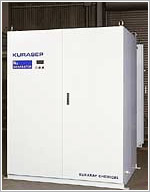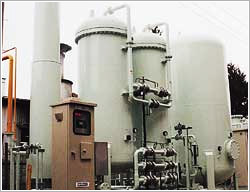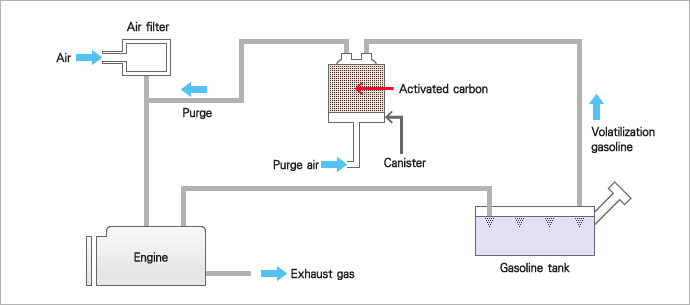Introduction of activated carbon | ApplicationsGas-phase
Air purification
Air conditioner
In precision instrument rooms, room for telephone exchange, and art galleries, pellet activated carbon or fiber-type activated carbon filter is used to prevent contamination or corrosion of precise equipment and art objects and to purify ventilation air. Activated carbon filters are also used in home air cleaners.
Gas mask
Activated carbon is used to adsorb volatile organic compounds, and impregnated carbon is used to adsorb acid gas, alkaline gas, and special gas.
Ozonolysis
Ozone is generated from purification plants where ozonation is performed and from copy machines. Such ozone is changed to oxygen by the catalytic action of the activated carbon. Granulated activated carbon is used in water purification plants, and honeycomb-type activated carbon is used for copy machines.
Deodorization
Treatment plants for sewage and human waste
Granular activated carbon and/or impregnated carbon is used for deodorization of sewage water or human waste. Odorants include sulfur compounds, such as hydrogen sulphide, ammonia, and mercaptan, etc. Threshold values of odorants are as follows.
| Material name | Threshold level: (ppm) |
Applied grade KURARAY COAL™ |
|---|---|---|
| ammonia | 1.5 | T-B |
| Methyl mercaptan | 0.00007 | GG, G-H |
| Hydrogen sulfide | 0.00041 | SA, G-H |
| Methyl sulfide | 0.003 | T-C |
| Trimethylamine | 0.000032 | T-B |
| Methyl disulfide | 0.0022 | GG, T-C |
| Acetaldehyde | 0.0015 | T-FU |
| styrene | 0.035 | GG, G-H |
| propionic acid | 0.0057 | GG |
| i-Valeric acid | 0.000078 | GG |
| Acetic acid | 0.006 | GG |
| n-Valeric acid | 0.000037 | GG |
| Material name | Threshold level: (ppm) |
Applied grade KURARAY COAL™ |
|---|---|---|
| Toluene | 0.33 | GG |
| Xylene | 0.38 | GG |
| acetic ether | 0.87 | GG |
| Methyl isobutyl ketone | 0.17 | GG |
| i-butanol | 0.011 | GG |
| Propionaldehyde | 0.001 | T-FU |
| n-butylaldehyde | 0.00067 | T-FU |
| i-Butyl aldehyde | 0.00035 | T-FU |
| n-valeraldehyde | 0.00041 | T-FU |
| i-valeraldehyde | 0.0001 | T-FU |
(Reference: Japan Environmental Sanitation Center)
(Written by: Yoshio Nagata, Norifumi Takeuchi)
Factory effluent gas
Various harmful gases are exhausted from plants depending on the type of industry. Activated carbon is selected according to the target gas composition.
Deodorant for refrigerator
Granular activated carbon is placed in a breathable container in the corner of the refrigerator. The refrigerator is deodorized by gas convection due to differences in temperature. The activated carbon has a life of about 1 year, and must be replaced with a new deodorizer. Kuraray is now developing long-life low-temperature deodorizing catalyst.
Gas separation, nitrogen separation in air (Nitrogen gas generator)

Nitrogen gas generator

With normal activated carbon, it is impossible to separate nitrogen and oxygen from the air. With the development of Carbon Malecular Sieves (CMS), separation of nitrogen and oxygen has become possible based on the differences in their adsorption speed: nitrogen (4.0×3.0Å), oxygen (3.9×2.8Å). At the beginning of adsorption, the difference in adsorption speed is large. Therefore, separation of nitrogen and oxygen is performed during the initial short period (1 or 2 min). The amount of adsorption increases when pressure is added, and adsorbed oxygen is desorbed when the pressure is decreased.
Use two towers filled with CMS and repeat adsorption and desorption alternately to separate nitrogen. The CMS and Nitrogen gas generator KURASEP™ is manufactured and distributed by Kuraray.
Other gas separation
Other examples of gas separation are as follows:
| Source gas | Composition ratio | Product gas (purity) |
|---|---|---|
| Methane: carbon dioxide | 60:40 | Methane (98%) |
| Hydrogen: carbon dioxide: Carbon monoxide | 75:23:2 | Hydrogen (99.999%) |
| Helium: air | 95:5 | Helium (99.99%) |
Solvent recovery
Activated carbon recover solvent exhausted from various plants, such as carbon disulfide at viscose rayon plants, acetone at acetate plants, and cyclohexanone at magnetic tape plants, etc. pelletized activated carbon (fixed bed), fibrous activated carbon (fixed bed), etc., are used. The catalytic properties of activated carbon are suppressed so that the recovered solvent does not change in quality.
Exhaust gas treatment
Flue gas desulfurization, denitrification
SOx and NOx are included in flue gas from thermal power generation or plants using coal as fuel. One method of desulfurization and denitrification is activated carbon adsorption. Adsorbed SOx is heated and collected as SO2. As the carbon in the activated carbon is exhausted at the time of desorption, new carbon is supplied. The grain size is 8 – 9 mm, which is rather large in terms of ventilation resistance.
Dioxin removal at incineration plants
Hazardous materials, such as dioxins, caused by incomplete combustion are included in gas exhausted from incineration plants. Dioxins can be removed by passing the exhaust gas through powdered activated carbon and lime.
For cigarettes
Activated carbon is used in cigarette filters in Japan, generally to improve smoke flavor. There are three types of filter made of activated carbon: acetate + acetate including activated carbon (dual filter), acetate + activated carbon + acetate (triple filter), paper including activated carbon (neo filter).
Canisters for vehicles
Gasoline vapor released from fuel tanks or carburetors when a vehicle drives or stops is a cause of air pollution. Therefore, the quantity of release is regulated in developed countries. A canister filled with activated carbon is connected to the source of gasoline vapor generation. The gasoline vapor is adsorbed in the activated carbon and is desorbed with clean air brought in when the vehicle drives. The desorbed gasoline vapor is burned with the engine. This canister is used semi-permanently to repeat adsorption and desorption.
This system is called the Evaporative Loss Control Device (ELCD). In the USA, the amount of gasoline vapor discharged when refueling a vehicle at a gas station is regulated. The canister is also used for this countermeasure. This system is called Onboard Refueling Vapor Recovery (ORVR). The activated carbon for this use should have a large capacity for gasoline adsorption and can easily desorb with clean air ventilation.

Gasoline evaporation loss prevention device
KURARAY COAL™ is used for vapor phase
KURARAY COAL™ is used for vapor phase as follows:
| Brand name | Shape | Grain size(mesh) | Application |
|---|---|---|---|
| PDX | Powder | 100 mesh or less | Removal and deodorization of dioxins |
| GG | Granular | 4×8, 8×14, 10×20 and others | Air purification, deodorization, cigarette filter |
| GS | Solvent, deodorization | ||
| GA | 4×8, etc. | Deodorization, gas separation | |
| KG | Granular | 8×28, etc. | Canister for vehicles |
| GG | Pelletized | 2, 3, 4 mm φ, etc. | Air purification, deodorization |
| GS | Solvent, deodorization | ||
| GA | Deodorization, gas separation | ||
| GN | 2 mm φ, etc. | Gas separation | |
| GM | 2, 3, 4 mm φ, etc. | ||
| SA | 4, 9 mm φ, etc. | Air purification, deodorization, exhaust gas treatment | |
| GK | 2, 3 mm φ, etc. | Canister for vehicles | |
| T-B | Granular | 4×8 mesh 4 mm φ | (Impregnated carbon) Deodorization of basic gas |
| G-H | Deodorization | ||
| T-C | (Impregnated carbon) Deodorization of sulfur compounds and organic matter | ||
| T-FU | (Impregnated carbon) Gas adsorption of aldehydes |
